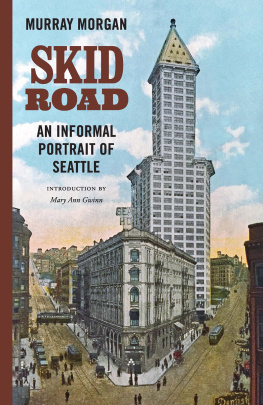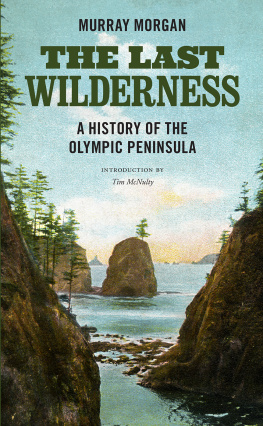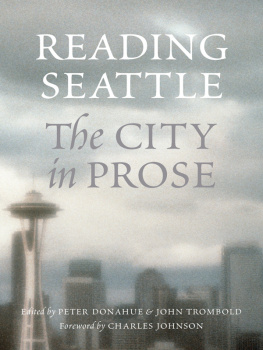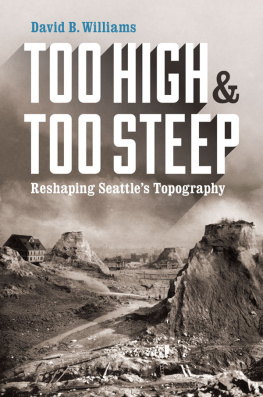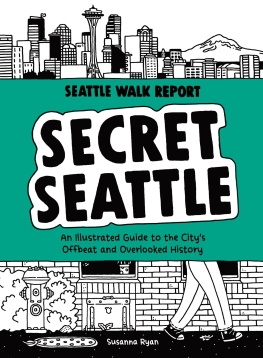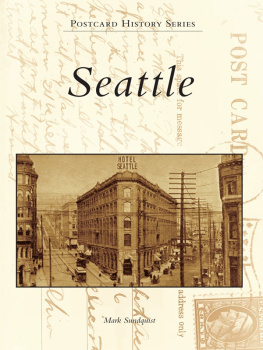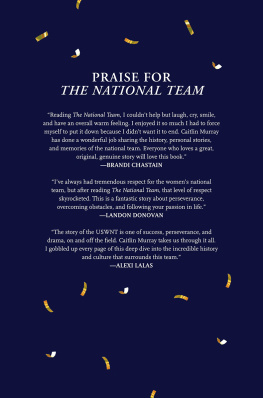
PRAISE FOR SKID ROAD
No one who has ever written Pacific Northwest history can match Murray Morgans craftsmanship, the signal virtues of which are pace, precision, humor, and a keen eye for the characterizing detail.
Pacific Northwest Quarterly
You can probably find this book lying around the house of anyone whos been in Seattle long enough to get even a little bit interested in the citys past. [Morgan is] exactly the kind of guy youd probably enjoy having show you around town.
The Stranger
Mr. Morgans book is the sort of corrective history that all communities should welcome.
New York Herald Tribune
Skid Road served as an accent to successive periods in Seattles history, from its gaudy boisterous uncontrolled days as the takeoff for the Alaskan gold fields, to the settling down to a staid respectability. There were days of questionable ethics, in journalism, in politics. There were reformers. And throughout, the exceptional personality of the city itself dominates its story.
Kirkus Reviews
Morgan portrays the people and the city with affection, delight, honesty and humor. More history should be written in this manner.
The Pacific Historian
SKID
ROAD

MURRAY MORGAN
Introduction by Mary Ann Gwinn
SKID
ROAD
AN INFORMAL PORTRAIT OF SEATTLE
UNIVERSITY OF WASHINGTON PRESS Seattle
Copyright 1951, 1960, 1971, 1978, 1982, by Murray Morgan
Introduction to the 2018 edition copyright 2018
by the University of Washington Press
Original cloth edition published in 1951 by Viking Press, Inc.
First paperback edition published in 1982 by the University of Washington Press
Printed and bound in the United States of America
Design by Thomas Eykemans
Composed in Adobe Garmond Pro
Cover artwork: Looking up at James Street at the left, Yesler Way at the right, from Pioneer Square. Showing the 42-story L. C. Smith Building. Photo by Curtis & Miller. C. 1920. Postcard collection (Record Series 9901-01), Seattle Municipal Archives
Author photograph by John Bickel
222120191854321
All rights reserved. No part of this publication may be reproduced or transmitted in any form or by any means, electronic or mechanical, including photocopy, recording, or any information storage or retrieval system, without permission in writing from the publisher.
UNIVERSITY OF WASHINGTON PRESS
www.washington.edu/uwpress
LIBRARY OF CONGRESS CATALOGING-IN-PUBLICATION DATA ON FILE
ISBN 978-0-295-74349-3 (pbk) | ISBN 978-0-295-74350-9 (ebook)
This book is for Howard and Judith Daniel
CONTENTS
Mary Ann Gwinn
.
INTRODUCTION
When I washed up on the shores of Seattle in 1983, I could not make sense of the place. Never mind the cattywampus street grid, where the north-south streets suddenly changed their minds and ran northwestwhat kind of town was this? It was prosperous enoughall those Boeing paychecksbut its citizens had a curious disregard for appearances. Some windburned, fleece-wrapped codger rolling down the streets of Ballard might have made millions fishing in Alaska. The people were a variety of ethnicities, completely different from the stark racial divides of the South, where I grew up and came of age. It was a tantalizing mix, but I couldnt figure out the recipe.
So I did what I have always done: I went looking for a book to explain it all. An editor in the Seattle Times newsroom, where I had landed a reporting job on the night shift, told me to check out the Elliott Bay Book Company, and I drove down to Pioneer Square on a dismal Saturday in February. I followed the signs into the bookstores basement caf, where patrons parked themselves at rickety wooden tables with a cup of coffee and a book (or two), then up the stairs to the main floor. I asked a clerk, a balding fellow with thick black-rimmed glasses, a salt-and-pepper beard, and a sweater that had seen better days, for advice. What book should I read to understand Seattle? Skid Road, he said without a beat of hesitation, pointing to the right of the cash register toward the Northwest history section.
There it was, a green-gray paperback with a cover photo of some old clapboard buildings, a raggedy clear-cut hill behind them. I paid for it out of my third paycheck, took it home, and read it in two sittings. I learned, as so many other people have from this book, why I had come to Seattle.
Skid Road, named for the muddy downhill track that split Seattle between its respectable precincts and its dark underbelly, where ox teams skidded logs to Yeslers Mill, is a history of Seattle told from the point of view of the misfits, geniuses, ideologues, and grifters who built our city on a foundation of dreams, greed, andevery so oftenregard for their fellow man. They had fled the East, where they didnt fit, and found a place where they did. They shaped their own hole to fit their personal peg, following the lead of the oddest character of allcity founder Doc Maynard, a mashup of a man with terrible business instincts and a heart of gold; a do-it-yourself do-gooder who adopted young children orphaned by an Indian raid; an anti-abolitionist who lived, worked with, and admired the Indians and learned their language, doctored their illnesses, drank their liquor, paddled their canoes.
In his preface to Skid Road, author Murray Morgan stated his mission:
This book is the story of Maynard and of the men like him, the ones who werent quite respectable but helped build the great city of the Northwest. The formal history of Seattle has been written many times over, sometimes well; the sons and daughters of the men who moved north of the Skid Road have lovingly told the story of the folk who dreamed the right dreams at the appropriate times. This is the story of the others, of some who tried and failed and of some who achieved success without becoming respectable, of the life that centered on the mills and on the wharves. That is Seattle from the bottom up.
I was one of those eastern dreamers who wandered west, and I found in Skid Road a portal into the history and character of a city Ive now called home for thirty-five years. Today I believe that Skid Road still says something elemental about Seattle. I am in distinguished company. Timothy Egan, the National Book Award-winning author whose own The Good Rain is another essential book about the Northwest, has this to say about Skid Road:
Over more than half a century, no one has written a better book about Seattle. I keep looking for something, but Skid Road has our soul down cold. That book absolutely inspired me when I set out to write The Good Rain, trying to get at what makes us tick in this corner of the country, and trying to bring history alive with a laugh. Before Skid Road, most history books of this region, and our city, were dry and drab, or booster pablum. Those books were about statues and railroads and number of airplanes built. Morgan dug deeper, and found something so much richer, and something the Chamber types would never have authorized. Were a quirky place. Our graft, our corruptions, our pretentions are unique to a city that tried to level its hills. The reason that book has achieved immortality is because its an honest look in the mirror. (Email to Mary Ann Gwinn, July 20, 2017)
Murray Morgan wrote a brilliant book, and readers embraced it:
Next page
